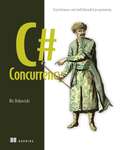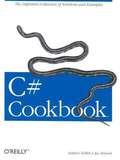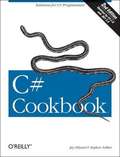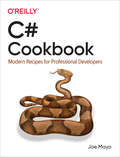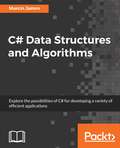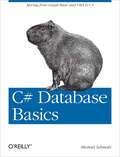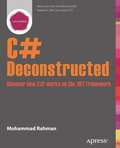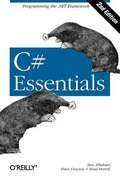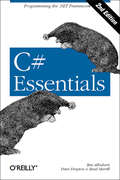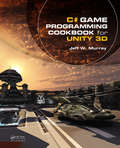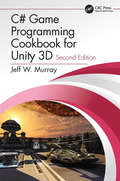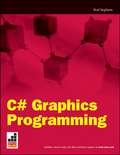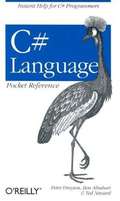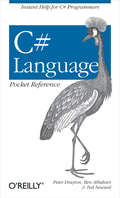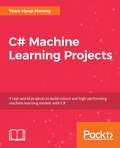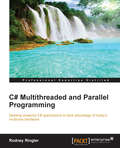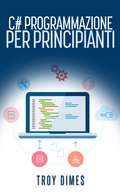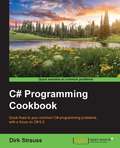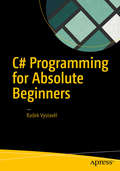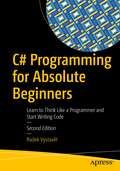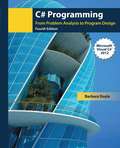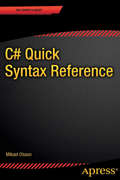- Table View
- List View
C# Concurrency: Asynchronous and multithreaded programming
by Nir DobovizkiSupercharge your applications with the ultimate guide to asynchronous and multithreaded programming in C#!C# Concurrency teaches you how to write effective multithreaded and asynchronous software in C#. Practical techniques, real-world examples, and useful code samples cut through the confusion around async/await and help you write rapid, reliable, and bug-free code. In C# Concurrency: Asynchronous and Multithreaded Programming you&’ll learn how to: • Take full advantage of async/await • Write bug-free multithreaded code every time • Create multithreaded code that delivers real performance improvements • Grok C# and .NET multithreading and asynchronous primitives • Know when to use concurrency techniques—and when not to use them! In C# Concurrency Nir Dobovizki, a seasoned C# veteran with over 30 years of high-performance programming experience, shares his deep knowledge and expert techniques. Say goodbye to frustrating pitfalls and impossible-to-find bugs that slow down your applications. Nir's careful approach will teach you how to navigate these challenges with ease, allowing you to achieve lightning-fast performance like never before! About the technology Asynchronous and multithreaded programs can perform multiple tasks simultaneously without losing speed or reliability. But getting concurrency right can challenge even experienced developers. This practical book teaches you to deliver concurrent C# apps that are lighting fast and free of the deadlocks and other synchronization issues that undermine performance and take forever to find. About the book C# Concurrency equips programmers with a comprehensive understanding of multithreading and asynchronous programming, focusing on the practical use of the C# async-await feature to simplify asynchronous tasks. It teaches how to avoid common pitfalls, addresses classic multithreading issues like deadlocks and race conditions, and advanced topics such as controlling thread of execution and using thread-safe collections. What's inside • .NET multithreading and asynchronous primitives • When to use concurrency techniques—and when not to! • Confidently use async/await About the reader For experienced C# programmers. No knowledge of asynchro- nous programming required. About the author Nir Dobovizki is a senior software architect and consultant who has worked on concurrent and asynchronous systems since the late 90s. Table of Contents 1 Asynchronous programming and multithreading 2 The compiler rewrites your code 3 The async and await keywords 4 Multithreading basics 5 async/await and multithreading 6 When to use async/await 7 Classic multithreading pitfalls and how to avoid them Part 2 8 Processing a sequence of items in the background 9 Canceling background tasks 10 Await your own events 11 Controlling on which thread your asynchronous code runs 12 Exceptions and async/await 13 Thread-safe collections 14 Generating collections asynchronously/await foreach and IAsyncEnumerable
C# Cookbook
by Jay Hilyard Stephen TeilhetThe C# Cookbook offers a definitive collection of solutions and examples for this new programming language. Recipes range from simple tasks to the more complex, and are organized with respect to the types of problems you'll need to solve as you progress in your experience as a C# programmer. Nearly every recipe contains a complete, documented code sample showing you how to solve the specific problem, as well as a discussion of how the underlying technology works and a discussion of alternatives, limitations, and other considerations where appropriate.
C# Cookbook
by Jay Hilyard Stephen TeilhetEasy to learn and use, the C# language is targeted at developers for Microsoft's .NET platform who've worked with a C-like language before, such as C, C++, or Java. There's no shortage of excellent tutorials and documentation to help new developers get a handle on the language, such as O'Reilly's Learning C# or Programming C# . But when you need practical answers to the day-to-day questions you run up against, a tutorial isn't going to do the trick. The C# Cookbook gets straight to the heart of the problem with code recipes collected especially for developers working on the .NET platform. The C# Cookbook offers a definitive collection of solutions and examples for this new programming language. Recipes range from simple tasks to the more complex, and are organized with respect to the types of problems you'll need to solve as you progress in your experience as a C# programmer. Nearly every recipe contains a complete, documented code sample showing you how to solve the specific problem, as well as a discussion of how the underlying technology works and a discussion of alternatives, limitations, and other considerations where appropriate. The recipes in the C# Cookbook are organized into seventeen chapters, each of which focuses on a particular topic in creating C# solutions. Among the topics covered, you'll find: Numeric data types in C# Strings and characters Classes and structures Exception handling Delegates and events Regular expressions Data structures and algorithms Networking Security Unsafe Code You don't need to be an experienced C# or .NET developer to use this book. The C# Cookbook is designed for users of all levels with recipes targeted at the real-world developer who needs to solve problems now, not learn lots of theory first. With this guide, all developers will be able to learn and improve their mastery of both the language and the .NET Framework Class Libraries.
C# Cookbook, 2nd Edition
by Jay Hilyard Stephen TeilhetWith C# Cookbook, 2nd Edition , you'll be able to learn and improve your mastery of both the C# language and the .NET platform. This updated bestseller has been completely revised to account for C# 2.0, the latest version of this popular object-oriented programming language. It also includes more than 100 new code solutions (over 300 overall) to common problems and tasks that you're sure to face as a C# programmer. Nearly every solution, or "recipe," contains a complete, documented code sample showing you how to solve the specific problem, as well as a detailed discussion of how and why the underling technology works. This question-solution-discussion format is a proven teaching method, as any fan of O'Reilly's "Cookbook" series can attest to. In fact, no other source offers a learn-as-you-go format quite like this. C# Cookbook, 2nd Edition is organized into 20 chapters, each of which focuses on a particular topic in creating C# solutions. Here's just a taste of what's covered: Numeric data types Strings and characters Classes and structures Generics Exception handling Delegates, events, and anonymous methods Filesystem interactions Web site access XML usage (including XPath and XSLT) Networking Threading Unsafe code Best of all, you don't have to be an experienced C# or .NET developer to use C# Cookbook, 2nd Edition . You just have to be someone who wants to solve a problem now, without having to learn all the related theory first.
C# Cookbook, 2nd Edition
by Jay Hilyard Stephen TeilhetWith C# Cookbook, 2nd Edition , you'll be able to learn and improve your mastery of both the C# language and the .NET platform. This updated bestseller has been completely revised to account for C# 2.0, the latest version of this popular object-oriented programming language. It also includes more than 100 new code solutions (over 300 overall) to common problems and tasks that you're sure to face as a C# programmer. Nearly every solution, or "recipe," contains a complete, documented code sample showing you how to solve the specific problem, as well as a detailed discussion of how and why the underling technology works. This question-solution-discussion format is a proven teaching method, as any fan of O'Reilly's "Cookbook" series can attest to. In fact, no other source offers a learn-as-you-go format quite like this. C# Cookbook, 2nd Edition is organized into 20 chapters, each of which focuses on a particular topic in creating C# solutions. Here are just some of what's covered: Numeric data types Strings and characters Classes and structures Generics Exception handling Delegates, events, and anonymous methods Filesystem interactions Web site access XML usage (including XPath and XSLT) Networking Threading Unsafe code Best of all, you don't have to be an experienced C# or .NET developer to use C# Cookbook, 2nd Edition . You just have to be someone who wants to solve a problem now, without having to learn all the related theory first.
C# Cookbook: Modern Recipes for Professional Developers
by Joe MayoEven if you're familiar with C# syntax, knowing how to combine various language features is a critical skill when you're building applications. This cookbook is packed full of recipes to help you solve issues for C# programming tasks you're likely to encounter. You'll learn tried-and-true techniques to help you achieve greater productivity and improve the quality of your code.Author and independent consultant Joe Mayo shares some of the most important practices you'll need to be successful as a C# developer. Each section of this cookbook describes some useful facet of the C# programming language. These recipes--the result of many years of experience--are proven concepts for solving real-world problems with C#.Recipes in this book will help you:Set up your project, manage object lifetime, and establish patternsImprove code quality through maintainability, error prevention, and correct syntaxUse LINQ to Objects for in-memory data manipulation and queryingUnderstand the differences between dynamic programming and reflectionApply several async programming features you may not be aware ofWork with data using newer libraries and algorithmsLearn different ways to use new C# features, such as pattern matching and records
C# Data Structures and Algorithms: Explore the possibilities of C# for developing a variety of efficient applications
by Marcin JamroA complete guide on using data structures and algorithms to write sophisticated C# codeKey Features Master array, set and map with trees and graphs, among other fundamental data structures Delve into effective design and implementation techniques to meet your software requirements Explore illustrations to present data structures and algorithms, as well as their analysis in a clear, visual manner.Book DescriptionData structures allow organizing data efficiently. They are critical to various problems and their suitable implementation can provide a complete solution that acts like reusable code. In this book, you will learn how to use various data structures while developing in the C# language as well as how to implement some of the most common algorithms used with such data structures.At the beginning, you will get to know arrays, lists, dictionaries, and sets together with real-world examples of your application. Then, you will learn how to create and use stacks and queues. In the following part of the book, the more complex data structures will be introduced, namely trees and graphs, together with some algorithms for searching the shortest path in a graph. We will also discuss how to organize the code in a manageable, consistent, and extendable way. By the end of the book,you will learn how to build components that are easy to understand, debug, and use in different applications.What you will learn How to use arrays and lists to get better results in complex scenarios Implement algorithms like the Tower of Hanoi on stacks of C# objects Build enhanced applications by using hashtables, dictionaries and sets Make a positive impact on efficiency of applications with tree traversal Effectively find the shortest path in the graph Who this book is forThis book is for developers who would like to learn the Data Structures and Algorithms in C#. Basic C# programming knowledge would be an added advantage.
C# Database Basics
by Michael SchmalzWorking with data and databases in C# certainly can be daunting if you're coming from VB6, VBA, or Access. With this hands-on guide, you'll shorten the learning curve considerably as you master accessing, adding, updating, and deleting data with C#--basic skills you need if you intend to program with this language. No previous knowledge of C# is necessary. By following the examples in this book, you'll learn how to tackle several database tasks in C#, such as working with SQL Server, building data entry forms, and using data in a web service. The book's code samples will help you get started on your own projects. Create a Windows Forms application with a datagrid Connect to multiple data sources, including Access and SQL Server Add, edit, and update data in a database you choose and design Enable users to choose their data source at runtime Learn the roles of DataTable, DataView, BindingSource, Filters, and other objects Understand where variables are declared and how they impact the code Build a simple web service that connects to a database
C# Database Basics: Moving from Visual Basic and VBA to C#
by Michael SchmalzWorking with data and databases in C# certainly can be daunting if you’re coming from VB6, VBA, or Access. With this hands-on guide, you’ll shorten the learning curve considerably as you master accessing, adding, updating, and deleting data with C#—basic skills you need if you intend to program with this language.No previous knowledge of C# is necessary. By following the examples in this book, you’ll learn how to tackle several database tasks in C#, such as working with SQL Server, building data entry forms, and using data in a web service. The book’s code samples will help you get started on your own projects.Create a Windows Forms application with a datagridConnect to multiple data sources, including Access and SQL ServerAdd, edit, and update data in a database you choose and designEnable users to choose their data source at runtimeLearn the roles of DataTable, DataView, BindingSource, Filters, and other objectsUnderstand where variables are declared and how they impact the codeBuild a simple web service that connects to a database
C# Deconstructed: Discover how C# works on the .NET Framework
by Mohammad RahmanC# Deconstructed answers a seemingly simply question: Just what is going on, exactly, when you run C# code on the . NET Framework? To answer this question we will dig ever deeper into the structure of the C# language and the onion-skin abstraction layers of the . NET Framework that underpins it. We'll follow the execution thread downwards, first to MSIL (Microsoft Intermediate Language) then down through just-in-time compilation into Machine Code before finally seeing the results executed at the hardware level. The aim of this deep-dive is to provide you with a much more rounded knowledge of the environment within which you code exists. As a managed language, it's best-practice to let the Framework deal with device interaction but you'll find the experience of taking the cover off once in a while a very rewarding one that will greatly enrich your appreciate of the C# language and the way in which in functions. What you'll learn Understand how C# handles your filesystem requests and passes them down to hard disks and memory Learn how RAM works and how programs map to address spaces Discover the C# compilation sequence in detail and follow it down from abstract code to actual function See how your device's micro-processor executes Machine Code and just-in-time compilation provides it when it's needed Learn how the Common Language Runtime (CLR) determines the execution of your code and handles Threading and Scheduling for your instructions Who this book is for This book is ideal for anyone who works with C# and has ever wondered what happens after they press F5. Table of Contents Anatomy of the C# compilation stack Data Access, Files and Storage Understanding Memory Usage The C# Compilation Sequence From CIL to Machine Code Execution through the CLR Execution Model II
C# Essentials, 2nd Edition
by Ben Albahari Peter Drayton Brad MerrillConcise but thorough, this second edition of C# Essentials introduces the Microsoft C# programming language, including the Microsoft .NET Common Language Runtime (CLR) and .NET Framework Class Libraries (FCL) that support it. This book?s compact format and terse presentation of key concepts serve as a roadmap to the online documentation included with the Microsoft .NET Framework SDK; the many examples provide much-needed context. This new edition has been updated to cover the final release of the C# language. In addition to overviews of C#, the CLR, and the FCL, this new edition of C# Essentials covers: Every C# language element and its syntax, in reference format, including new keywords The major C# datatypes, with code examples Common C# programming tasks Interoperation with legacy Win32 APIs and COM components, and the use of C/C++ style pointers within the managed context of the CLR Common development issues C# Essentials is an easy way for experienced programmers to evaluate and get up to speed quickly on the language best suited to developing web applications and services on the new Microsoft .NET platform.
C# Essentials: Programming the .NET Framework
by Ben Albahari Peter Drayton Brad MerrillConcise but thorough, this second edition of C# Essentials introduces the Microsoft C# programming language, including the Microsoft .NET Common Language Runtime (CLR) and .NET Framework Class Libraries (FCL) that support it. This book?s compact format and terse presentation of key concepts serve as a roadmap to the online documentation included with the Microsoft .NET Framework SDK; the many examples provide much-needed context.This new edition has been updated to cover the final release of the C# language. In addition to overviews of C#, the CLR, and the FCL, this new edition of C# Essentials covers:Every C# language element and its syntax, in reference format, including new keywordsThe major C# datatypes, with code examplesCommon C# programming tasksInteroperation with legacy Win32 APIs and COM components, and the use of C/C++ style pointers within the managed context of the CLRCommon development issuesC# Essentials is an easy way for experienced programmers to evaluate and get up to speed quickly on the language best suited to developing web applications and services on the new Microsoft .NET platform.
C# Game Programming Cookbook for Unity 3D
by Jeff W. MurrayAn Accessible, Modular Style of Game Building-Easily Start Making Games with Unity 3DC# Game Programming Cookbook for Unity 3D presents a highly flexible core framework to create just about any type of game by plugging in different script components. Most scripts function within the game framework or in your own structures. The techniques and conce
C# Game Programming Cookbook for Unity 3D
by Jeff W. MurrayThis second edition of C# Game Programming Cookbook for Unity 3D expounds upon the first with more details and techniques. With a fresh array of chapters, updated C# code and examples, Jeff W. Murray’s book will help the reader understand structured game development in Unity unlike ever before. New to this edition is a step-by-step tutorial for building a 2D infinite runner game from the framework and scripts included in the book. The book contains a flexible and reusable framework in C# suitable for all game types. From game state handling to audio mixers to asynchronous scene loading, the focus of this book is building a reusable structure to take care of many of the most used systems. Improve your game's sound in a dedicated audio chapter covering topics such as audio mixers, fading, and audio ducking effects, or dissect a fully featured racing game with car physics, lap counting, artificial intelligence steering behaviors, and game management. Use this book to guide your way through all the required code and framework to build a multi-level arena blaster game. Features Focuses on programming, structure, and an industry-level, C#-based framework Extensive breakdowns of all the important classes Example projects illustrate and break down common and important Unity C# programming concepts, such as coroutines, singletons, static variables, inheritance, and scriptable objects. Three fully playable example games with source code: a 2D infinite runner, an arena blaster, and an isometric racing game The script library includes a base Game Manager, timed and proximity spawning, save profile manager, weapons control, artificial intelligence controllers (path following, target chasing and line-of-sight patrolling behaviors), user interface Canvas management and fading, car physics controllers, and more. Code and screenshots have been updated with the latest versions of Unity. These updates will help illustrate how to create 2D games and 3D games based on the most up-to-date methods and techniques. Experienced C# programmers will discover ways to structure Unity projects for reusability and scalability. The concepts offered within the book are instrumental to mastering C# and Unity. In his game career spanning more than 20 years, Jeff W. Murray has worked with some of the world's largest brands as a Game Designer, Programmer, and Director. A Unity user for over 14 years, he now works as a consultant and freelancer between developing his own VR games and experiments with Unity.
C# Graphics Programming
by Rod StephensThis Wrox Blox teaches you how to add graphics to C# 2008 applications, explaining fundamental graphics techniques such as: drawing shapes with different colors and line styles; filling areas with colors, gradients, and patterns; drawing text that is properly aligned, sized, and clipped exactly where you want it; manipulating images and saving results in bitmap, JPEG, and other types of files. Also covered are instructions for how to greatly increase your graphics capabilities using transformations. Transformations allow you to move, stretch, or rotate graphics. They also let you work in coordinate systems that make sense for your application. You will also learn how to use all of these techniques in printouts. The author describes the sequence of events that produce a printout and shows how to generate and preview printouts.The final sections describe two powerful new graphic tools that were introduced with .NET Framework 3.0: WPF graphics and FlowDocuments. WPF applications can use XAML graphic commands to declaratively draw and fill the same kinds of shapes that a program can draw by using graphics objects.Finally, a discussion on the FlowDocument object shows you how to define items that should be flowed across multiple pages as space permits. This lets you display text, graphics, controls, and other items that automatically flow across page breaks. FlowDocument viewers make displaying these documents easy for you, and simplifies the user's reading of the documents.This Wrox Blox also contains 35 example programs written in C# 2008, although most of the code works in previous versions of C# as well. The most notable exceptions are WPF graphics and FlowDocuments, both of which require WPF provided in .NET Framework 3.0 and later.
C# Language Pocket Reference
by Ben Albahari Peter Drayton Ted NewardC# programmers all have one thing in common -- they're learning a new language. That fact alone brings challenges, frustrations, and constant demands on your patience. And, no matter how good your reference books are, you can't always stop to thumb through hundreds of pages to find the piece of information you need. Your answer is the C# Language Pocket Reference . Concise and easy to use, this handy pocket guide to C# comes from the authors of C# in a Nutshell , and is a must-have quick reference for anyone implementing this new object-oriented language. The C# Language Pocket Reference offers the convenience of a quick reference in a format that will actually fit in your pocket. The book includes a guide to C# language elements, a brief overview of the Framework Class library, a cross-reference for namespaces and assemblies, a list of compiler syntax and switches, a regular expressions reference guide, and more. You'll be surprised at how much information can fit into this slim volume. O'Reilly's Pocket References have become a favorite among programmers everywhere. By providing a wealth of important details in a concise, well-organized format, these handy books deliver just what you need to complete the task at hand. When you've reached a sticking point in your work and need to get to a solution quickly, the new C# Language Pocket Reference is the book you'll want to have.
C# Language Pocket Reference
by Ben Albahari Peter Drayton Ted NewardC# programmers all have one thing in common -- they're learning a new language. That fact alone brings challenges, frustrations, and constant demands on your patience. And, no matter how good your reference books are, you can't always stop to thumb through hundreds of pages to find the piece of information you need. Your answer is the C# Language Pocket Reference. Concise and easy to use, this handy pocket guide to C# comes from the authors of C# in a Nutshell, and is a must-have quick reference for anyone implementing this new object-oriented language.The C# Language Pocket Reference offers the convenience of a quick reference in a format that will actually fit in your pocket. The book includes a guide to C# language elements, a brief overview of the Framework Class library, a cross-reference for namespaces and assemblies, a list of compiler syntax and switches, a regular expressions reference guide, and more. You'll be surprised at how much information can fit into this slim volume.O'Reilly's Pocket References have become a favorite among programmers everywhere. By providing a wealth of important details in a concise, well-organized format, these handy books deliver just what you need to complete the task at hand. When you've reached a sticking point in your work and need to get to a solution quickly, the new C# Language Pocket Reference is the book you'll want to have.
C# Machine Learning Projects: Nine real-world projects to build robust and high-performing machine learning models with C#
by Yoon Hyup HwangPower your C# and .NET applications with exciting machine learning models and modular projectsKey FeaturesProduce classification, regression, association, and clustering modelsExpand your understanding of machine learning and C# Get to grips with C# packages such as Accord.net, LiveCharts, and DeedleBook DescriptionMachine learning is applied in almost all kinds of real-world surroundings and industries, right from medicine to advertising; from finance to scientifc research. This book will help you learn how to choose a model for your problem, how to evaluate the performance of your models, and how you can use C# to build machine learning models for your future projects. You will get an overview of the machine learning systems and how you, as a C# and .NET developer, can apply your existing knowledge to the wide gamut of intelligent applications, all through a project-based approach. You will start by setting up your C# environment for machine learning with the required packages, Accord.NET, LiveCharts, and Deedle. We will then take you right from building classifcation models for spam email fltering and applying NLP techniques to Twitter sentiment analysis, to time-series and regression analysis for forecastingforeign exchange rates and house prices, as well as drawing insights on customer segments in e-commerce. You will then build a recommendation model for music genre recommendation and an image recognition model for handwritten digits. Lastly, you will learn how to detect anomalies in network and credit card transaction data for cyber attack and credit card fraud detections.By the end of this book, you will be putting your skills in practice and implementing your machine learning knowledge in real projects.What you will learnSet up the C# environment for machine learning with required packagesBuild classification models for spam email filteringGet to grips with feature engineering using NLP techniques for Twitter sentiment analysisForecast foreign exchange rates using continuous and time-series dataMake a recommendation model for music genre recommendationFamiliarize yourself with munging image data and Neural Network models for handwritten-digit recognitionUse Principal Component Analysis (PCA) for cyber attack detectionOne-Class Support Vector Machine for credit card fraud detectionWho this book is forIf you're a C# or .NET developer with good knowledge of C#, then this book is perfect for you to get Machine Learning into your projects and make smarter applications.
C# Multithreaded and Parallel Programming
by Rodney RinglerIf you are a C# developer and want to learn how to take advantage of the features of .NET for concurrent and multithreaded applications, then this book is for you. If you are already comfortable with C# but want to learn more about parallel design patterns, threads, tasks, and async, then look no further!
C# Programmazione per principianti
by Alessandro Consorti Troy DimesUna delle cose migliori di C# è che è facile da imparare ... soprattutto con questo libro. Descrizione libro Data di pubblicazione: 23 gen 2015 C # è semplice, ma potente. C # è un linguaggio di programmazione orientato agli oggetti semplice e polivalente. Combinate questo con la sua versatilità e l'enorme libreria standard e sarà facile capire perché è un linguaggio di programmazione popolare e rispettato. Creare applicazioni grafiche, applicazioni web based, e altro ancora. Quando si impara a programmare in C# si sarà in grado di sviluppare applicazioni basate su web o applicazioni desktop grafiche. Una delle cose migliori di C# è che è facile da imparare ... soprattutto con questo libro. Ecco solo alcune delle cose che imparerete ... Cos'è un IDE e quale si dovrebbe utilizzare per lo sviluppo di applicazioni C#. Come creare il vostro primo programma. I vari tipi di dati utilizzati in C#. Gli operatori ... aritmetici, relazionali e logici. Come iterare in un insieme di elementi utilizzando 4 diversi tipi di cicli. Metodi per prendere decisioni nel codice. A proposito di programmazione orientata agli oggetti (OOP). Cosa sono gli oggetti e le classi. Tutto su modificatori e metodi. Argomenti avanzati come ereditarietà e polimorfismo. Come creare applicazioni multi-thread per sfruttare più CPU in una sola volta. Altro ... Esercizi di pratica inclusi che aiutano a realizzare codice C# che esegua "click" per voi. Include un esercizio alla fine di ogni capitolo (insieme alla soluzione) in modo da poter mettere in pratica ciò che avete imparato. Ottimo per programmatori che iniziano o quelli che sono nuovi al linguaggio Java. Se non avete mai programmato prima, non preoccupatevi. Questo libro vi guiderà passo per passo nella creazione della vostra prima applicazione software. Se avete qualche esperienza di programmazione
C# Programming Cookbook
by Dirk StraussQuick fixes to your common C# programming problems, with a focus on C# 6.0 About This Book * Unique recipes for C#, that places it in its real-world context. * You will be able to get yourself out of any coding-corner youve backed yourself into. * All code samples available through GitHub to bring C#. * In line with modern development workflows, written to the latest specification of C# 6.0. Who This Book Is For The book is aimed at developers who have basic familiarity with C# programming and will know the VS 2015 environment. What You Will Learn * Write better and less code to achieve the same result as in previous versions of C#. * Generate tests from the Code Contracts for mission critical methods. * Integrate code in Visual Studio with GitHub. * Create a web application in Azure. * Design and build a microservice architecture * Demystify the Rx library using Reactive extensions * Write high performing codes in C# and understanding multi-threading. * Security and Debugging. * Implement Code Contracts on code in Visual Studio. In Detail During your application development workflow, there is always a moment when you need to get out of a tight spot. Through a recipe-based approach, this book will help you overcome common programming problems and get your applications ready to face the modern world. We start with C# 6, giving you hands-on experience with the new language features. Next, we work through the tasks that you perform on a daily basis such as working with strings, generics, and lots more. Gradually, we move on to more advanced topics such as the concept of object-oriented programming, asynchronous programming, reactive extensions, and code contracts. You will learn responsive high performance programming in C# and how to create applications with Azure. Next, we will review the choices available when choosing a source control solution. At the end of the book, we will show you how to create secure and robust code, and will help you ramp up your skills when using the new version of C# 6 and Visual Studio Style and Approach Unique recipe-based guide that will help you gain a solid understanding of the new concepts in C# 6 and Visual Studio Enterprise 2015 in a concise and technically correct manner.
C# Programming for Absolute Beginners
by Radek VystavělGet started using the C# programming language. Based on the author’s 15 years of experience teaching beginners, the book provides you with a step-by-step introduction to the principles of programming, or rather, how to think like a programmer. The task-solution approach will get you immersed, with minimum theory and maximum action.What You Will LearnUnderstand what programming is all aboutWrite simple, but non-trivial, programsBecome familiar with basic programming constructs such as statements, types, variables, conditions, and loopsLearn to think like a programmer and combine these programming constructs in new waysGet to know C# as a modern, mainstream programming language, and Visual Studio as one of the world’s most popular programming toolsWho This Book Is ForThose with very little or no experience in computer programming, who know how to use a computer, install a program, and navigate the web.
C# Programming for Absolute Beginners: Learn to Think Like a Programmer and Start Writing Code
by Radek VystavělGet started using the C# programming language. Based on the author’s 15 years of experience teaching beginners, this book provides you with a step-by-step introduction to the principles of programming, or rather, how to think like a programmer. The task-solution approach will get you immersed, with minimum theory and maximum action.What You Will LearnUnderstand what programming is all aboutWrite simple, but non-trivial, programsBecome familiar with basic programming constructs such as statements, types, variables, conditions, and loopsThink like a programmer and combine these programming constructs in new waysGet to know C# as a modern, mainstream programming language, and Visual Studio as one of the world’s most popular programming toolsWho This Book Is ForThose with very little or no experience in computer programming, who know how to use a computer, install a program, and navigate the web
C# Programming: From Problem Analysis to Program Design
by Barbara DoyleOnly Doyle's C# PROGRAMMING: FROM PROBLEM ANALYSIS TO PROGRAM DESIGN, 4E brilliantly balances today's most important programming principles and concepts with the latest insights into C#. This perfect introductory book highlights the latest Visual Studio 2012 and C# 4. 0 with a unique, principles-based approach to give readers a deep understanding of programming. You'll find just the right amount of detail to create an important foundation in programming. This edition's straightforward approach and understandable vocabulary make it easier for readers to grasp new programming concepts without distraction. The book introduces a variety of fundamental programming concepts, from data types and expressions to arrays and collections, all using the popular C# language. New programming exercises and new numbered examples throughout this edition reflect the latest updates in Visual Studio 2012, while learning objectives, case studies and Coding Standards summaries in each chapter ensure mastery. While the book assumes no prior programming knowledge, coverage extends beyond traditional books to cover new advanced topics, such as portable class libraries used to create applications for Windows Phone and other platforms.
C# Quick Syntax Reference: A Pocket Guide To The Language, Apis And Library
by Mikael OlssonThe C# Quick Syntax Reference is a condensed code and syntax reference to the C# programming language. It presents the essential C# syntax in a well-organized format that can be used as a handy reference. You won’t find any technical jargon, bloated samples, drawn out history lessons or witty stories in this book. What you will find is a language reference that is concise, to the point and highly accessible. The book is packed with useful information and is a must-have for any C# programmer. In the C# Quick Syntax Reference, you will find: · A concise reference to the C# language syntax. · Short, simple and focused code examples. · A well laid out table of contents and a comprehensive index allowing easy review. What you’ll learn How to write your first C#-based HelloWorld as well as compile and run What are variables, operators, strings, arrays, conditionals, loops, methods What are and how to use the rich set of Classes in C# How to do inheritance, member redefinitions, access levels, statics, properties and more How to work with indexers, interfaces, abstracts, namespaces, and more How to use enums, exception handling, operator overloading, custom conversions, constants What are and how to use preprocessor, delegates, events, generics and struct Who this book is for This book is a handy, pocket quick syntax reference for experienced C# as well as perhaps other programmers even new to C#.
